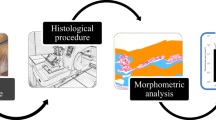Summary
The aim of this study was to evaluate the bone stimulation forced by Demineralized Bone Matrix (DBM)-Chips and – Gel in comparison to the bone –ingrowth into a porous hydroxylapatite ceramic (Endobon) in mini pigs. The following results were obtained:
1. DBM-Chips and DBM-Gel did not stimulate bone healing when filled into cancellous bone defects. The defect did not heal within 12 weeks.
2. Up to 35 days the least amount of new bone formation was observed within porous hydroxylapatite ceramic. Up to 12 weeks completly bone ingrowth in to the ceramic has been seen with close bonding between new formed bone and the ceramic trabeculae.
3. By continuous labelling with fluorochromes the new bone formation could be analysed by fluorescence microscopy and the dynamics could be related to time after implantation.
Zusammenfassung
Das Hauptziel dieser Arbeit war es, in vergleichenden Untersuchungen am Minischwein die Stimulation der Knochenheilung im ersatzstarken Lager durch demineralisierte „bone-matrix-chips“ (DBM) sowie DBM-Gel (Grafton) gegen die knöcherne Integration einer Hydroxylapatitkeramik (Endobon) zu untersuchen. Folgende Ergebnisse konnten erzielt werden:
1. Allogene DBM in Chips- und in Gelform hatte keine osteostimulative Wirkungen auf die Knochenheilung im ersatzstarkem Lager. Nach 12 Wochen war der Defekt bei beiden Applikationsarten der DBM noch nicht knöchern durchbaut.
2. Der Knocheneinwuchs bis zum 35. Tag bei der Pressfit-implantierten HA-Keramik Endobon war nur randständig, während nach 12 Wochen die Keramik vollständig knöchern durchbaut war. Es kam zu einem engen Keramikknochenverbund.
3. Diese Ergebnisse im Rahmen der vorliegenden tierexperimentellen Untersuchung konnten durch eine zeitgerechte Dynamik der Knochenneu- und -umbildungen anhand von histologischen Fluoreszenzübersichten ermittelt werden. Die zeitliche Bestimmung der Knocheneinheilrate wurde durch tägliche Markierung der Tiere mit fluoreszierenden Farbstoffen ermöglicht.
Similar content being viewed by others
Author information
Authors and Affiliations
Rights and permissions
About this article
Cite this article
Schnettler, R., Dingeldein, E. & Herr, G. Defect filling with demineralized bone matrix.. Orthopäde 27, 80–88 (1998). https://doi.org/10.1007/PL00003482
Published:
Issue Date:
DOI: https://doi.org/10.1007/PL00003482




